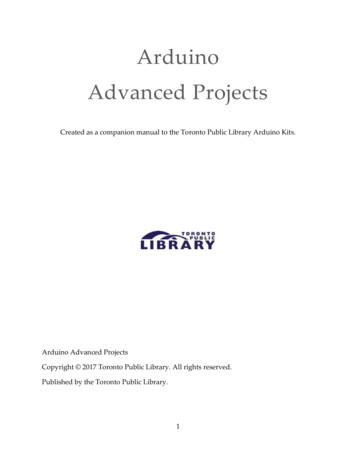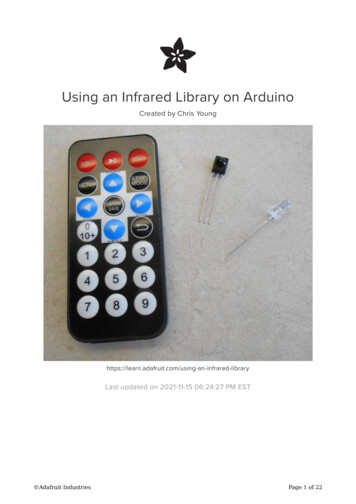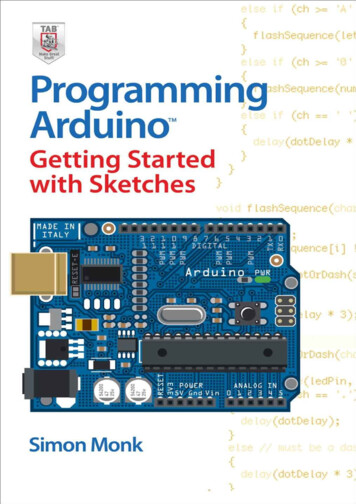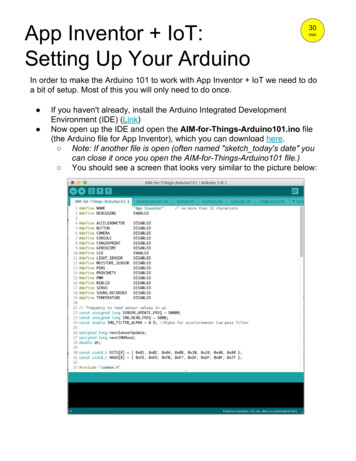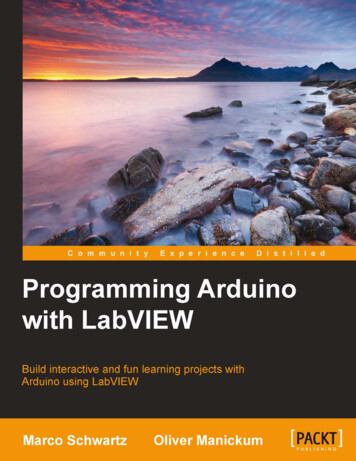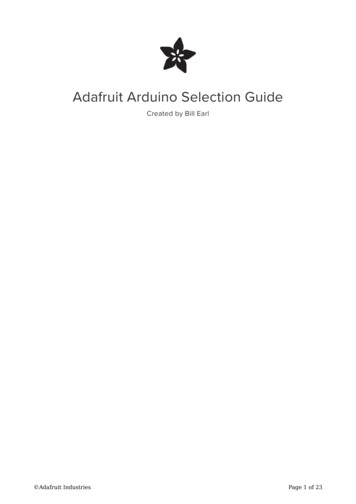
Transcription
Adafruit Arduino Selection GuideCreated by Bill Earl Adafruit IndustriesPage 1 of 23
ion-guideLast updated on 2022-03-17 10:19:13 AM EDT Adafruit IndustriesPage 2 of 23
Table of ContentsSelecting an Arduino5 5667Your first Arduino?Looking for an upgrade?Wrapping it up!By the numbersGetting Started7 Real Beginners:Programmers:the Electronics Tinkerer:Everyone:9101111Bigger and Better Projects12 ForForForForTime for an Upgrade?More Pins!More Connectivity!More Memory!More Speed!1213141616Big Ideas in Small Packages17 18192021Keep it Small!Not Too Tall!Integrate!Wear it with Pride!Arduino Comparison Chart Adafruit Industries22Page 3 of 23
Adafruit IndustriesPage 4 of 23
Selecting an ArduinoSo many Arduinos, so little time.There are many different Arduino and Arduino Compatible microcontroller boards.Which one is right for your needs? This guide will help you to select a board that bestfits your project requirements and/or level of expertise. Whether you are just learningthe ropes or have specific project requirements in mind, the Adafruit ArduinoSelection Guide can help you to make the right choice.Your first Arduino?If you are new to Arduinos, the "GettingStarted" page will help you select the rightboard and get you set up with theaccessories you need to get going withyour new Arduino. Adafruit IndustriesPage 5 of 23
Looking for an upgrade?If you are looking to step up to an Arduinowith more memory, pins or horsepower,head straight to the "Bigger and BetterProjects" page.Wrapping it up!So you have tested and debugged yourproject on the breadboard and arewondering how to package it nicely.Maybe even make it portable or wearable.In that case, head over to the "Big Ideas inSmall Packages" page. Adafruit IndustriesPage 6 of 23
By the numbersIf you know exactly what you need and justwant to know which boards have it, checkout our handy Arduino Comparison Chart.No Arduinos were harmed in the making of this guide.Getting StartedIf you are just getting started with the Arduino, congratulations and welcome to theworld of microcontrollers and electronics! Adafruit IndustriesPage 7 of 23
For most people getting started with the Arduino, the Arduino UNO is an excellentchoice for a number of reasons:The UNO is the best documented and best supported of the Arduinos - if not the bestdocumented and best supported microcontroller development board in the world.Seriously! There are hundreds of books, forums and blogs full of helpful Arduinoinformation and project ideas. Almost all of this information is specifically about orapplicable to the UNO.At Adafruit alone, in addition to our helpful support forums, we have dozens of tutorials. These include the outstanding Arduino Lesson (https://adafru.it/Cch) series by Dr.Simon Monk (http://adafru.it/1019). As well as product tutorials (https://adafru.it/c51) for Adafruit IndustriesPage 8 of 23
almost all of our Arduino compatible products.The UNO is also the most compatible of all the Arduinos. Almost all existing Arduino libraries and shields are compatible with the UNO. And the UNO will run just about allof the code that has been written for earlier versions of the Arduino such as theDuemilanove and Diecimila. When you start to branch out into more ambitiousprojects and interface to more different devices, compatibility is an importantconsideration.For Real Beginners:If you are new to both electronics andprogramming, you should consider one ofour starter kits. These kits all include anArduino Uno and a selection ofaccessories and electronic components toget you going.The Adafruit Budget Starter Pack (http://adafru.it/193) contains the processor, USBcable, a breadboard and some basiccomponents.The full Adafruit Starter Pack (http://adafru.it/68) adds a power supply and aproto-shield kit so you can make yourcircuits permanent after you debug themon the breadboard.The Arduino Starter Kit (http://adafru.it/1078) comes direct from the Arduino teamand includes supplies to build some funand interesting projects. The starter kit hasbeen developed together with a series often video tutorials hosted by Arduino cofounder Massimo Banzi (https://adafru.it/c52). Read more about the kit onArduino.cc (https://adafru.it/c53) Adafruit IndustriesPage 9 of 23
For Programmers:If you have some programming experienceand want to get your feet wet withelectronics, any of the Adafruit starter kitsmentioned above will give you a goodselection of parts to start with. Adafruit IndustriesPage 10 of 23
For the Electronics Tinkerer:So you know your electronics and want totry your had at programming? Youprobably have a good selection ofcommon components already, so a bareUno (http://adafru.it/50)might be a goodplace to start. You may also want to pickup a power supply (http://adafru.it/63) anda USB cable (http://adafru.it/62).You are no doubt already handy with asoldering iron, so you may also want toconsider building yourself an ArduinoCompatible Menta (http://adafru.it/795).For this you will need an FTDICable (http://adafru.it/70) instead of thestandard USB cable.For Everyone:Congratulations on getting started anddon't forget to reward your new skills withan Arduino Badge! (http://adafru.it/1300) Adafruit IndustriesPage 11 of 23
Bigger and Better ProjectsTime for an Upgrade?So your project has outgrown the Uno and you need something more. There aremany options for expansion: There are many Arduino boards with more pins, morememory, more connectivity and/or more computing power compared to the Uno.But first keep in mind that moving to a processor with more capabilities than the Uno'sAtmega 328P comes with some trade-offs in compatibility. Although many of theseboards have headers that are laid out to accept standard Arduino shields, the pinoutsof all these boards are somewhat different. Adafruit IndustriesPage 12 of 23
SPI, i2c, PWM and Pin change interrupts are on different pins from a standardArduino. In addition to all that, the Due runs at 3.3v, and many libraries have not yetbeen ported to support the Due's ARM processor.So use this guide to help you select a board that will take your project to the nextlevel. But be aware that it may not be 100% "Plug & Play" with all the shields. See ourShield Compatibility Guide (https://adafru.it/cB7) for more details.More Pins!Stepping up to an Arduino Mega (http://adafru.it/191) gives you 40 extra digital pinsand 10 more analog input pins.The Arduino Mega ADK (http://adafru.it/563) also adds a USB port designed forintegrating with Android devices.The Arduino Due (http://adafru.it/1076)gives you 40 extra digital pins, 6 extraanalog input pins and 2 analog outputpins. Adafruit IndustriesPage 13 of 23
More Connectivity!The Arduino Ethernet (http://adafru.it/418)is the simplest way to make your projectpart of the Internet of Things. As a bonus,it comes with a built-in SD card.The Megas and the Due mentioned aboveall have 4 hardware serial ports forefficient communication with serialdevices.The Due, Leonardo (http://adafru.it/849),Micro (http://adafru.it/1086)andFlora (http://adafru.it/659) all have nativeUSB capabilities, so they can emulatekeyboards, mice etc.The Due also supports the CAN bus popular for automotive applications. Adafruit IndustriesPage 14 of 23
Adafruit IndustriesPage 15 of 23
More Memory!Having trouble fitting your code into Flash?Is you sketch crashing from lack of SRAM?Either of the Megas will give you 8X theFlash and 4X the SRAM.A Due has 16X the Flash and 48X theSRAM compared to an Arduino Uno!More Speed!Almost all the Arduinos are based on 8-bitmicrocontrollers running at 16MHz. TheMegas have more pins and memory, butthey won't make your code run any faster.The Arduino Due is based on a 32-bit ARMprocessor running at 84MHz. The Due isthe clear winner in the speed department. Adafruit IndustriesPage 16 of 23
Big Ideas in Small PackagesSo you want to make your project a bit less bulky or need to fit it into a confinedspace - maybe even make it wearable. There are many great options for embeddableor wearable Arduino projects. Adafruit IndustriesPage 17 of 23
Keep it Small!The DC Boardino (http://adafru.it/72) andUSB Boarduino (http://adafru.it/91) are themost Uno Compatible options. They areabout 1/3 the size of an Uno but use thesame Atmega 328P processor. Your Unosketches should run without change. TheBoarduinos can be built without sockets orheaders for a lower profile. The DCversion can be made even more compactby eliminating the voltage regulatorsection of the board if you already have aregulated 5v supply.The Flora (http://adafru.it/659)is bothsmall and thin! It uses the same processoras the Leonardo, but takes up less thanhalf the area.The smallest of all is the Micro (http://adafru.it/1086). This is about 2/3 the size ofthe Boarduino and also uses the 32U4.Your Leonardo projects should easily portto the Flora or Micro. Adafruit IndustriesPage 18 of 23
Not Too Tall!A standard Arduino with headers is prettychunky, and plugging things into theheaders only makes it bulkier.The Leonardo is available in a headerlessversion (http://adafru.it/883). and theFlora (http://adafru.it/659) has no headerseither.Both the DC Boarduino (http://adafru.it/72)and the USB Boarduino (http://adafru.it/91)can be built without sockets or headers tomake a thinner package. Adafruit IndustriesPage 19 of 23
Integrate!Sure you can switch to a tinier processor,but what do you do with the rest of theelectronics? Short of a custom circuitboard, there is the Adafruit Menta (http://adafru.it/795) with its built-in prototypingarea.The Menta is sized to slip into a mint-tin fora simple and attractive package. But theyare also great for any embedded projectthat needs some custom circuitry.The Menta uses an Atmega 328, so it iscompatible with the Uno, and it hasstandard Arduino headers for excellentshield compatibility! Adafruit IndustriesPage 20 of 23
Wear it with Pride!While many of these compact processorscould be worked into a project you couldwear. The Flora (http://adafru.it/659) isspecifically designed for wearableprojects.In addition to the thin profile and sewableconnections, these processors aredesigned with rounded shapes that arefabric friendly with no protruding pins orsharp edges to snag on fabrics.With their attractive appearance andselection of similarly styled Floraperipherals (https://adafru.it/c54), theseare the boards to go to when you want towear your microprocessor on your sleeve.The Flora is based on the Atmega 32U4processor, so it is largely LeonardoCompatible. Adafruit IndustriesPage 21 of 23
Arduino Comparison ChartThe following table compares the basic features of the various Arduinos and ArduinoCompatibles mentioned in this guide. (click for a larger view).For shield compatibility, be sure to check our Shield Compatibility Guide (https://adafru.it/cB7). Adafruit IndustriesPage 22 of 23
*On the 32U4 processors there is some overlap between the Analog Input and DigitalI/O pins, so the total number of I/O pins will be less than the sum of the two. Adafruit IndustriesPage 23 of 23
check out our handy Arduino Comparison Chart. No Arduinos were harmed in the making of this guide. Getting Started If you are just getting started with the Arduino, congratulations and welcome to the world of microcontrollers and




